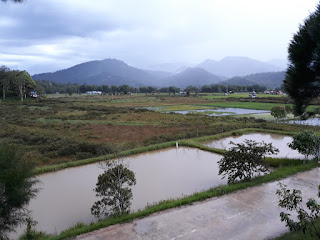MASwings: Miri to Bario flight experience
Bario "the land of a hundred handshakes" is a community of villages located on the Kelabit Highlands deep within Sarawak's interior, close to the Sarawak-Indonesia border. Bario is home of the Kelabit tribe and is known for its welcoming scenery, cool climate, and the hospitality of the local people.


While remoteness gave Bario its beauty and pristine environment, it also made accessing the town very difficult as there are no proper, paved access roads to the town from the outside. The only road connecting Bario to the district capital, Miri, is a rugged logging trail which is navigable using a four-wheel drive vehicle only. The journey from Miri to Bario by 4WD can take anywhere between 10 and 30 hours depending on the weather and road conditions.

Despite its remoteness and isolation from the outside world, Bario does have a small airport with regular scheduled commercial flights that bring both people and goods into or out of the town. This travelogue details my travel experiences on one of these flights to Bario.
Introduction: Flight to Bario
Bario is served by MASwings under the Rural Air Services (RAS) Agreement. The RAS Agreement is a subsidy programme run by the Federal Government providing subsidised air travel to/from rural communities located deep within Sarawak and Sabah's interiors. Through the RAS Agreement, people from the rural communities now have better access to medical care, emergency aid, and education.
MASwings is a wholly owned subsidiary of Malaysia Airlines charged with operating regional flights within Sabah, Sarawak, and Labuan, as well as operating RAS flights.

From Bario, there are three daily flights to/from Miri, either direct or via Marudi. On certain days of the week, there are also direct flights to neighbouring villages such as Ba'kelalan, Long Seridan, and Long Lellang.

Part I: Checking in at Miri Airport
Miri Airport (MYY, WBGR) is the main aerial gateway to Sarawak's interior. From here, there regular scheduled commercial flights to remote communities including Bario.

MYY's airport terminal is a two-storey building with a utilitarian architecture.

Check-in counters at Miri Airport. For RAS flights, check-in must be done at the counters. There are no web check-in, mobile check-in, or self-service check-in facilities for RAS flights.

During check-in, both passenger and his/her carry-on baggage must be weighed. This is a safety measure to ensure that the aircraft does not fly overweight, and that all weights are properly distributed within the aircraft.
The Twin Otter aircraft used in RAS flights is a small aircraft and has strict restrictions on payload weight and weight distribution.

Four boarding passes were issued: two for the onward trip (Miri - Marudi, Marudi - Bario), and two for the return trip (Bario - Marudi, Marudi - Miri).

Entrance to the transit area is located on the second floor.

Inside the departure waiting lounge.

Part II: MH3600 - Miri to Marudi
Boarding calls were made 20 minutes before take-off.

Heading down to another waiting room.

Inside the Twin Otter waiting room. Boarding will only commence after all passengers and both pilots have been accounted for.

Walking towards the Twin Otter parking stands.

9M-SSF "Kemena", ready for boarding as flight MH3600 Miri - Marudi - Long Lellang.

Interior of the DHC-6 Twin Otter. Each Twin Otter seats 19 passengers.

View of the flight deck, with the first officer going through pre-start-up checklist.

View of the DHC-6-400's safety card.


View of the Pratt & Whitney PT6A-34 turboprop engine.

Taxiing out to runway.

Taking off from Runway 02.

Flying towardsd Marudi at a height of 8,000 feet.

Landed at Marudi 12 minutes later.

As most of the passengers were transiting through Marudi, their baggage were unloaded from 9M-SSF.

View of Marudi Airport's terminal.

The simple, no-nonsense arrival hall.

9M-SSF left for Long Lellang after a short 15-minute stopover.

Part III: MH3722 - Marudi to Bario
My connecting flight to Bario arrived less than 10 minutes after 9M-SSF's departure.

Ground staff pulling baggage cart out to the apron.

I then made my way to the departure waiting hall to wait for my flight.

9M-SSA "Rajang" will take me to Bario as flight MH3722

Due to Bario's remoteness, goods such as soft drinks and instant noodles have to be flown in. Also seen here in the photo was a metal pole used to prevent the tail from tipping over during cargo loading.

Taxiing out to runway.

Performing short take-off from Runway 28. The Twin Otter is a STOL (short take-off and landing) aircraft, and is capable of taking from runways as short as 366 metres.

Flying over the thick Bornean jungles at 8,000 feet. Mulu Airport can been seen in the photo.

As seen in the photo, the pilot used the radar to look out for turbulent air and flew manually to avoid inclement weather.

Descending over Bario. The aircraft would fly past the airport, make a 180-degree turn, and land on Runway 29.

Touched down at Bario.

Back-taxiing at the end of Runway 29.

Welcome to Bario, home of the Kelabit.

Unloading in progress.

View of Bario Airport's terminal.

An arch welcomes you to Bario in three languages: English, Bahasa Malaysia, and Kelabit. Your homestay or accommodation at Bario will usually arrange for an airport transfer with or without extra cost. If a transfer is not available, you can make your way on foot or hitch a ride on a fellow villager's pick-up.




Comments
Post a Comment